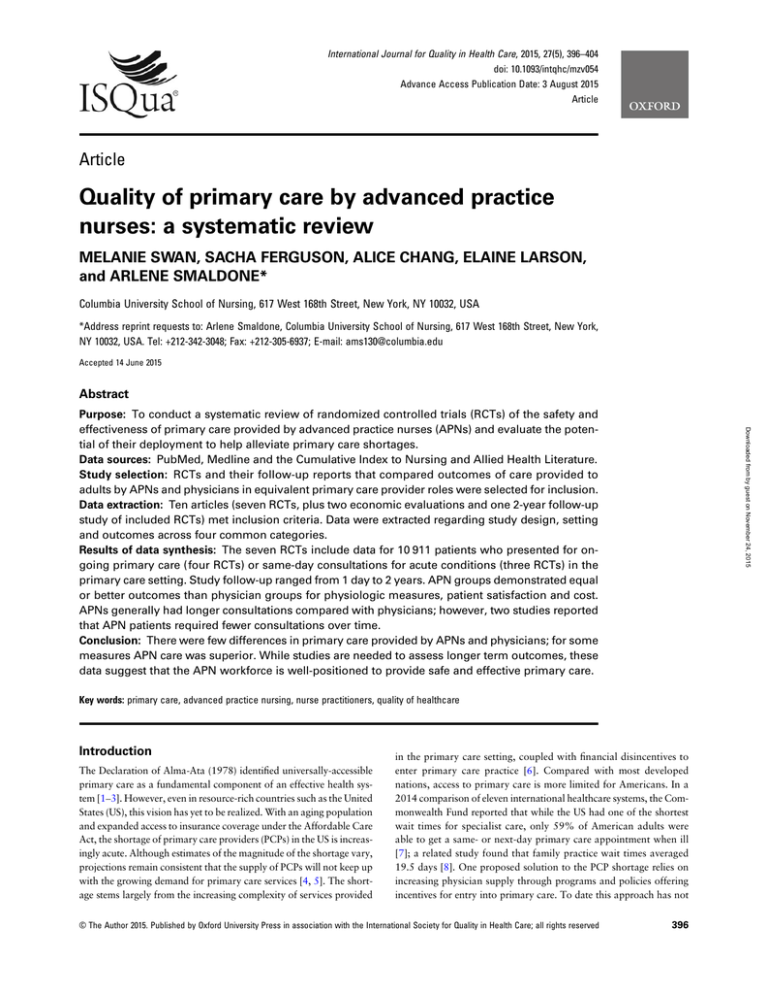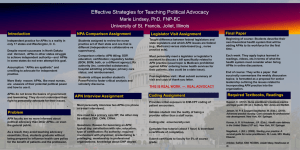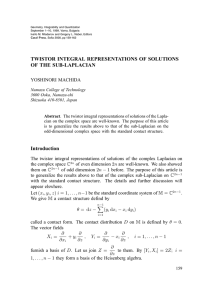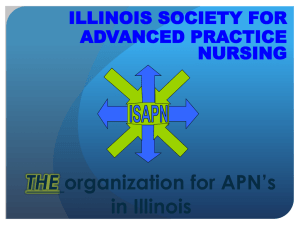Document 13306234
advertisement

International Journal for Quality in Health Care, 2015, 27(5), 396–404 doi: 10.1093/intqhc/mzv054 Advance Access Publication Date: 3 August 2015 Article Article Quality of primary care by advanced practice nurses: a systematic review MELANIE SWAN, SACHA FERGUSON, ALICE CHANG, ELAINE LARSON, and ARLENE SMALDONE* Columbia University School of Nursing, 617 West 168th Street, New York, NY 10032, USA *Address reprint requests to: Arlene Smaldone, Columbia University School of Nursing, 617 West 168th Street, New York, NY 10032, USA. Tel: +212-342-3048; Fax: +212-305-6937; E-mail: ams130@columbia.edu Accepted 14 June 2015 Abstract Downloaded from by guest on November 24, 2015 Purpose: To conduct a systematic review of randomized controlled trials (RCTs) of the safety and effectiveness of primary care provided by advanced practice nurses (APNs) and evaluate the potential of their deployment to help alleviate primary care shortages. Data sources: PubMed, Medline and the Cumulative Index to Nursing and Allied Health Literature. Study selection: RCTs and their follow-up reports that compared outcomes of care provided to adults by APNs and physicians in equivalent primary care provider roles were selected for inclusion. Data extraction: Ten articles (seven RCTs, plus two economic evaluations and one 2-year follow-up study of included RCTs) met inclusion criteria. Data were extracted regarding study design, setting and outcomes across four common categories. Results of data synthesis: The seven RCTs include data for 10 911 patients who presented for ongoing primary care (four RCTs) or same-day consultations for acute conditions (three RCTs) in the primary care setting. Study follow-up ranged from 1 day to 2 years. APN groups demonstrated equal or better outcomes than physician groups for physiologic measures, patient satisfaction and cost. APNs generally had longer consultations compared with physicians; however, two studies reported that APN patients required fewer consultations over time. Conclusion: There were few differences in primary care provided by APNs and physicians; for some measures APN care was superior. While studies are needed to assess longer term outcomes, these data suggest that the APN workforce is well-positioned to provide safe and effective primary care. Key words: primary care, advanced practice nursing, nurse practitioners, quality of healthcare Introduction The Declaration of Alma-Ata (1978) identified universally-accessible primary care as a fundamental component of an effective health system [1–3]. However, even in resource-rich countries such as the United States (US), this vision has yet to be realized. With an aging population and expanded access to insurance coverage under the Affordable Care Act, the shortage of primary care providers (PCPs) in the US is increasingly acute. Although estimates of the magnitude of the shortage vary, projections remain consistent that the supply of PCPs will not keep up with the growing demand for primary care services [4, 5]. The shortage stems largely from the increasing complexity of services provided in the primary care setting, coupled with financial disincentives to enter primary care practice [6]. Compared with most developed nations, access to primary care is more limited for Americans. In a 2014 comparison of eleven international healthcare systems, the Commonwealth Fund reported that while the US had one of the shortest wait times for specialist care, only 59% of American adults were able to get a same- or next-day primary care appointment when ill [7]; a related study found that family practice wait times averaged 19.5 days [8]. One proposed solution to the PCP shortage relies on increasing physician supply through programs and policies offering incentives for entry into primary care. To date this approach has not © The Author 2015. Published by Oxford University Press in association with the International Society for Quality in Health Care; all rights reserved 396 Quality of primary care by APNs • Patient Outcomes been successful, offers no guarantee of success and, even if successful, requires considerable lead time and high cost [9]. An alternative approach is to maximize utilization of nonphysician providers, including nurse practitioners (NPs) and other advanced practice nurses (APNs), physician assistants and midwives in primary care delivery. These provider types receive different training with different scopes of practice defined by state legislation. In the US, the supply of NPs is growing rapidly [5, 10] with NPs more likely to specialize in primary care than their physician counterparts. Currently more than 75% of NPs in the US practice in at least one primary care site [11]. Hence, full deployment and expanded use of NPs is one promising strategy to alleviate the primary care shortage and is consistent with the Institute of Medicine Future of Nursing Report recommendation that nurses should practice to the full extent of their education and training [12]. Previous systematic reviews examining outcomes of NP and other APN care have demonstrated favorable results; however, they are either outdated [13], not limited to the primary care setting [14–17], include studies with designs other than randomized controlled trials (RCTs) [13–19], include studies which do not compare outcomes of APNs and physicians in comparable roles [15, 18, 20] or include studies in which the APN is not in a PCP role [21]. The purpose of this systematic review is to evaluate data from RCTs regarding the cost and quality of care provided by APNs in primary care. Literature search The guidelines set forth in the Preferred Reporting Items for Systematic Reviews and Meta-Analyses (PRISMA) Statement [22] were followed. PubMed, Medline and the Cumulative Index to Nursing and Allied Health Literature (CINAHL) were systematically searched with assistance from an information specialist expert in systematic review methods to identify RCTs comparing outcomes of care provided to adults by APNs and physicians in the primary care setting. Initially, broad categories of search terms were selected, including: APN, patient outcomes, primary care and RCT. Specific terms within each category were then identified (for example, the category for APN included the terms ‘nurse practitioner,’ ‘nurse clinicians,’ ‘advanced practice nursing,’ et cetera). Terms were entered generally and expanded to include medical subject heading (MeSH) terms where available. Similar search terms were listed using database-specific commands such as ADJ or * (wildcard) to ensure inclusion of relevant articles (for example: family NPs, patient satisfaction, family health clinic, random* stud*). All possible combinations of the terms from each category were then searched to locate target studies (see Supplementary Appendix). Additional search criteria included presence of an abstract and English language publication. No date restriction was employed. Inclusion criteria included RCTs comparing primary care outcomes of APNs and physicians, as well as any publications stemming from these RCTs providing longer term follow-up or economic evaluation of the included RCT samples. APNs were defined as nurses who had received additional formal education and training that expanded their scope of practice to include services traditionally considered to fall under the practice of medicine, such as diagnosis and treatment of medical conditions. Exclusion criteria included review articles, non-RCT design or no original data, studies in which APN care was not the independent variable and studies with entirely pediatric samples (due to the variation in outcomes of interest between adult and pediatric patients, which would impede data aggregation). Additionally, the APN role in the study had to be that of a PCP, with an educational background allowing them to manage their own panel of patients. After removing duplicates, reviewers screened titles to identify articles that met inclusion and exclusion criteria. Next, abstracts and full text of identified studies were independently assessed by two reviewers. Discrepancies regarding whether a study met inclusion criteria and/or whether the role of APNs was equivalent to that of a PCP were discussed among reviewers until consensus was attained. Reference lists of included articles as well as previously-published systematic reviews were hand-searched for any additional RCTs satisfying inclusion and exclusion criteria. Quality appraisal The Cochrane Collaboration’s tool for assessing risk of bias was used to assess study quality [23]. The instrument contains seven criteria: random sequence generation, allocation concealment, blinding of participants and personnel, blinding of outcome assessor, incomplete outcome data, selective outcome reporting and other bias. Each criterion has detailed directions for making judgments about risk of bias and is rated as high, low or unclear. Two independent reviewers rated the quality of each study and discrepancies were discussed until consensus was reached among all authors. For studies that included a cost outcome, the Quality of Health Economic Studies (QHES) instrument [24, 25] was also used, including 16 criteria scored as ‘met’ or ‘not met’. Each criterion receives a weighted score ranging from 1 to 9 points totaling 0–100 points. Two reviewers (EL, AS) independently appraised each economic evaluation; where scores differed, agreement was achieved by consensus. Data extraction and synthesis Data regarding study sample and setting, design and outcomes were extracted including sample size, patient characteristics and attrition rates, number and location of practices and providers, treatment description and duration, points of data collection, outcomes measured and statistical techniques. Outcomes assessed in multiple studies were then synthesized to provide comparison across studies. Results Literature search The initial search identified 784 articles. Among these, 109 were duplicates. Upon further screening, 512 articles were removed based on title review and 125 based on abstract review. Thirty were then excluded based on a review of the entire article, the most common reason for exclusion being that the study examined outcomes of care by nurses who were not acting in a PCP role. One publication, despite several requests for inter-library loan, could not be located and was excluded [26]. Two additional RCTs were identified during the hand search [27, 28] resulting in a final total of 10 articles: seven RCTs [27–33], a 2-year follow-up of the sample from the Mundinger et al. RCT [34] and two economic evaluations of an included RCT [35, 36]. Figure 1 summarizes the literature search. Study characteristics The ten included studies represent data from 10 911 subjects who participated in seven RCTs (Table 1). Five studies were conducted in Europe [27, 29–31, 33]. One study and its 2-year follow-up were conducted in the US [32, 34]. Subjects were randomized when they Downloaded from by guest on November 24, 2015 Methods 397 Swan et al. 398 Downloaded from by guest on November 24, 2015 Figure 1 Flow diagram of literature search. CINAHL, Cumulative Index to Nursing and Allied Health Literature; APN, advanced practice nurse; PCP, primary care provider; RCT, randomized controlled trial. presented for a general [28, 32] or diabetes-focused primary care visit [27, 30], or for same-day consultation for any reason [31, 33] or for a pre-defined list of conditions and/or diabetes-related care [29]. One study limited recruitment to adults without a usual source of care during an emergency room visit and targeted a high proportion with chronic conditions such as asthma, diabetes mellitus and hypertension [32]. The number of providers varied by study ranging from 2 [28, 30] to 12 [29, 31] APNs and 2 [28] to 50 [29] physicians. Two studies did not describe the number of providers [27, 33]. In two studies control group subjects saw both a physician and ‘standard nurse’ who provided patient education, while care to those randomized to the intervention group was provided solely by the APN [27, 28]. APN scope of practice and titles used for APNs and physicians varied across studies. Restrictions on APN practice included the requirement for APN prescriptions to be co-signed by the general practitioner [33] and APN use of a defined treatment protocol for diabetes-related care [27, 30]. One study reported that both APN and physician providers had the same resources, such as hospital admitting privileges, available to them [32]. Subject follow-up ranged from 1 day [29] to 2 years [34]. Quality appraisal Randomized controlled trials The majority of studies fell in the low risk of bias category across five of the seven criteria. For allocation concealment, risk of bias was low Author, year, country Sample, setting Provider type (number), intervention description Dierick-van Daele, 2009, 2010a The Netherlands APN group N = 817; physician group N = 684 Age (years): 42.8 ± 16.5 APN group, 46.1 ± 16.6 physician group Race/ethnicity: NR 15 general practices NP (n = 12) vs. general practitioner Data collection: • Baseline (n = 50) Single consultation for pre-defined list • Immediately after visit of problems; any follow-up over Attrition 32.8% at 2 weeks for 2 week duration follow-up questionnaire data, 6.9% for medical data Houweling, 2009 The Netherlands APN group N = 50; physician group N = 43 Nurse specialized in diabetes (n = NR) Age (years): 63.1 ± 10.6 APN group, vs. internist (n = NR) 59.6 ± 10.6 physician group All diabetes care, including blood Race/ethnicity: NR pressure and lipid management, over 2 hospital associated diabetes outpatient clinics 12 month duration APN group N = 116; physician group N = 114 Age (years): 67.1 ± 11.0 APN group, 69.5 ± 10.6 physician group Race/ethnicity: NR Single group practice Practice nurse (n = 2) vs. general practitioner (n = 2) All diabetes care, including blood pressure and lipid management, over 14 month duration Kinnersley, 2000 England and Wales APN group N = NR; physician group N = NR; total N = 1465 Age ≥16 years: 62% APN group, 68% physician group Race/ethnicity: NR 10 general practices NP (n = 10) vs. general practitioner (n = NR) Same-day consultation; any follow-up over 4 week duration Mundinger, 2000 and Lenz, 2004b United States APN group N = 1181 (222b); physician group N = 800 (184b) Age (years): 45.5 ± NR APN group, 46.7 ± NR physician group Race/ethnicity: 90.3% Hispanic 5 primary care clinics at an urban academic medical center NP (n = 7) vs. physician (n = 17) All primary care services over 1 year duration Data collection: • Baseline • 6 months • 12 months Attrition 9.7% at 12 months Data collection: • Baseline • 14 months Attrition 10.4% at 14 months Main outcomes Effectiveness of consultation (health status) Patient satisfaction Direct costsa Productivity lossa Healthcare resource utilization Adherence to guidelines Physiologic measures (hemoglobin A1c, blood pressure, lipid profile, BMI) Quality of life, symptoms Patient satisfaction Healthcare costs Healthcare resource utilization Physiologic measures (hemoglobin A1c, blood pressure, lipid profile, BMI) Quality of life, symptoms Patient satisfaction Process indicators (appropriate preventive care, therapy intensification) Data collection: Baseline Immediately after initial visit 2 weeks 4 weeks (audit data) Attrition 25% at 2 weeks for questionnaire data, 11% at 4 weeks for audit data Symptom resolution Patient satisfaction Healthcare resource utilization Patient education Patient intentions for future care Data collection: Baseline Immediately after initial visit 6 months 1 year 2 yearsb Attrition 0.05% at 6 months for medical data; 21% at 6 months for interview data Physiologic measures (glycosylated hemoglobin, blood pressure, peak flow) Health status Patient satisfaction Healthcare resource utilization • • • • • • • • • 399 Table continued Downloaded from by guest on November 24, 2015 Houweling, 2011 The Netherlands Data collection time points, attrition rate Quality of primary care by APNs • Patient Outcomes Table 1 Characteristics of included studies Swan et al. Health status Patient satisfaction Cost of care Healthcare resource utilization Attrition 24% at 2 weeks Data collection: • Baseline • 2 weeks Table 2 summarizes select physiologic, patient satisfaction, cost and resource use outcomes for each study. In three studies, outcome monitoring ended no more than 4 weeks from the time of the initial study visit [29, 31, 33]; in one study subject follow-up was limited to 1 day [29]. A single study reported long-term outcomes of patients retained in care at 2 years [34]. APN, advanced practice nurse; NR, not reported; BMI, body mass index. a Economic evaluation of randomized control trial. b Two-year follow-up of 406 subjects. NP (n = NR) vs. general practitioner (n = NR) Same-day consultation plus any follow-up within 2 week duration Venning, 2000 England and Wales APN group N = 651; physician group N = 665 Age >16 years: 67% Race/ethnicity: NR 20 general practices Attrition: NR Physiologic measures (mortality, physical function, social and emotional function) Patient satisfaction Cost of care, financial performancea Healthcare resource utilizationa Quality of care, adherence to guidelines NP (n = 2) vs. family physician (n = 2) All primary care services over 1 year duration Spitzer, 1974, 1976a Canada Author, year, country APN group N = 1529; physician group N = 2796 (selected for interview cohort: APN group N = 340; physician group N = 614) Age >15 years: 80% Race/ethnicity: NR Large suburban primary care practice Outcomes results Provider type (number), intervention description Data collection: Economic evaluations Two economic evaluations [35, 36] were conducted alongside the RCTs [28, 29] with scores of 51 (9 criteria met) [36] and 86 (13 criteria met) [35]. Both studies provided adequate description of their methodology for measuring and/or estimating cost and clearly described primary outcome measures. One [35] stated the perspective from which the study was completed, conducted a sensitivity analysis of the cost estimate under varying assumptions and measured health outcomes using valid and reliable scales. Sample, setting • Baseline • 1 year or unclear risk, and for random sequence generation the majority of studies demonstrated unclear risk (Fig. 2). Four studies were unclear regarding the methods used for random sequence generation [28, 30–32], two showed low risk [29, 33] and one demonstrated high risk of inadequate random sequence generation [27]. Four studies reported their method of allocation concealment [29, 31–33]. Study personnel [27–29, 32] and outcome assessors [27, 28, 30–33] were blinded in the majority of studies. Four studies had low risk of incomplete outcomes data [27, 28, 30, 32] while three had high risk due to high attrition rates [29, 31, 33]. Six studies had a low risk of selective outcome reporting [27–30, 32, 33]. No significant risk of bias was identified in the ‘other bias’ category for any of the RCTs. Physiologic measures Three RCTs [27, 30, 32] and one follow-up study [34] assessed blood pressure and glucose outcomes, and two [27, 30] reported lipid outcomes. Between-group differences were generally not significant, with the exception of the cholesterol/high-density lipoprotein (HDL) ratio [27] and the diastolic blood pressure at 6 months [32] with both favoring the APN group. Additional physiologic measures were investigated in single studies with no differences between APN and physician groups for mortality [28], change in body mass index (BMI) [27, 30], change in LDL [27] or peak expiratory flow rate [32, 34]. All studies investigated subjective health status; instruments used included the Medical Outcomes Short Form 36 (SF-36) [32–34], burden of illness and the EQ5-D [29], measures of disability or impaired activities of daily living and emotional and social functioning [28] and measures of symptoms and symptom resolution [27, 30, 31] with no differences between groups. Patient satisfaction All studies examined patient satisfaction. Four RCTs [27, 30, 31, 33] and one follow-up study [34] used existing validated instruments, two [29, 32] adapted existing instruments and one [28] did not specify the tool used to measure satisfaction. Three studies demonstrated higher patient satisfaction among patients who received care from APNs [27, 30, 33], and one study reported higher satisfaction among patients who received care from APNs at three of their ten study sites [31]. Downloaded from by guest on November 24, 2015 Table 1 Continued Data collection time points, attrition rate Main outcomes 400 Quality of primary care by APNs • Patient Outcomes 401 Cost of care Four studies (two RCTs [27, 33] and two economic evaluations [35, 36]) examined differences in costs of care. Three studies estimated cost using provider salary; of these, two [27, 35] found that APN care was less expensive compared with physician provided care. One study examined annual laboratory and monthly medication costs; while APN care was less expensive for laboratory services (64.9 ± 34.5 versus 91.5 ± 36.7 euros, P = 0.001), there were no differences in monthly medication costs [27]. Spitzer et al., 1976, examined cost of care by developing a Utilization and Financial Index in which provider salary was aggregated with laboratory, radiology, hospital costs and out of pocket expenditures; no differences were observed between care provided by APNs and physicians [36]. Healthcare resource utilization All studies reported healthcare resource utilization outcomes. Four studies [27, 29, 31, 33] examined consultation length; of these, three found that APN consultations were 3.0 [29] to 4.3 [33] minutes longer than those provided by physicians [29, 31, 33]. Two RCTs and one follow-up study examined total number of primary care visits with conflicting findings at 1 year [27, 32] but fewer visits among APN patients at 2 years [34]. One RCT [32] and its follow-up study [34] examined hospitalization and emergency department or urgent care visits with no significant differences between groups. Three studies [29, 31, 33] examined the number of referrals made and two [32, 34] investigated the number of specialty care visits; both found no differences between APNs and physicians. Of three studies that examined follow-up adherence [29, 31, 33], two [29, 33] reported that APNs more frequently requested a return visit and their patients were more likely to keep the appointment. Three studies examined the prescription patterns for medications and diagnostic tests [29, 31, 33]; one [33] reported that APNs more frequently ordered diagnostic tests with no differences in medication prescriptive practices. Process measures Four studies examined other clinical process measures. Three [28–30] assessed clinician guideline adherence; one found that APNs had higher rates of providing disease-appropriate care across five of six indicators examined [30]. Kinnersley et al., reported that patients assigned to the physician group were less likely to report having been told the cause of their illness (odds ratio [OR] 0.58, 95% confidence interval [CI] 0.44–0.76), how to relieve symptoms (OR 0.32, 95% CI 0.24–0.43) and what to do if the problem persisted (OR 0.61, 95% CI 0.41–0.90) [31]. There were no differences regarding the proportion reporting that they were advised of the likely duration of their illness and how to reduce the chances of recurrence. Discussion Findings of this systematic review suggest that APNs in primary care settings perform as well as physicians in terms of clinical outcomes and patient satisfaction. Results were mixed across studies regarding whether APNs ordered more diagnostic tests, and some evidence suggested APNs more frequently asked patients to return to the clinic after a consultation. APN consultations took slightly longer than physician consultations, but did not translate to overall increased costs. There was also evidence suggesting that APN patients required fewer total Downloaded from by guest on November 24, 2015 Figure 2 Summary of quality appraisal of RCTs. Swan et al. 402 Table 2 Selected outcomes results Author, year Outcomes: APN group vs. physician group Physiologic Patient satisfaction (Instrument) Cost Healthcare resource utilization Dierick-van N/A Daele, 2009, 2010a 8.2 ± 1.2 vs. 8.2 ± 1.3 (Investigator-developed instrument) Direct cost per consultation based on salary (euros): 31.9 ± 36.3 vs. 40.2 ± 49.9a** Houweling, 2009 73.9 vs. 53.3%* [Patients’ Evaluation of the Quality of Diabetes Care (PEQD)] Total salary costs over 12 months (euros): 114.6 ± 50.4 vs. 138.3 ± 48.3*** Consultation duration (min): 12.2 vs. 9.2* Referrals ( percent of consultations): 12.0 vs. 14.2% Number of prescriptions per consultation: • 1: 55.0 vs. 54.2% • 2: 16.9 vs. 19.5% • ≥3: 8.8 vs. 7.8% Consultation duration over 12 months (min): 272.0 ± 120.5 vs. 249.2 ± 110.7 Primary care visits over 12 months: 7.4 ± 3.0 vs. 9.8 ± 3.8** 66.4 vs. 51.7% (PEQD) N/A N/A Mean score range across practice sites: 72.9–79.5 vs. 68.7–79.5% [Consultation Satisfaction Questionnaire (CSQ)] N/A Consultation duration: 10 vs. 6 min (statistically significant) Referrals ( percent of consultations): 5 vs. 5% Prescription issued ( percent of consultations): 63 vs. 63% Change (95% CI) over 12 months: • Systolic BP: −8.6 (−2.6, −14.7) vs. −4.0 (0.9, −8.9) mmHg • Diastolic BP: −1.4 (1.4, −4.1) vs. −2.4 (0.8, −4.9) mmHg • Total cholesterol: −0.4 (−0.2, −0.6) vs. −0.9 (−0.5, −1.3) mmol/l • Cholesterol/HDL ratio: −0.4 (0.1, −0.6) vs. −0.9 (−0.5, −1.4)*** • HbA1c: −1.5 (−1.0, −1.9) Houweling, 2011 Mundinger, 2000 Lenz, 2004b Value at 6 months: Initial consultation: 4.59 vs. N/A • Systolic BP: 137 vs.139 mmHg 4.60 • Diastolic BP: 82 vs. 85 mmHg*** At 6 months: 4.45 vs. 4.46 • Glycosylated hemoglobin: 9.5 vs. (Investigator-developed 9.4% instrument based on Medical Value at 2 years: Outcomes Study) • Systolic BP: 139.0 vs. 141.9 mmHgb At 2 years: mean score range • Diastolic BP: 85.9 vs. 88.1 mmHgb across categories 65.4–90.8 • Glycosylated hemoglobin: 8.9 vs. vs. 67.6–94.4%b 10.3%b [Patient Care Assessment Survey (PCAS)] Primary care visits at 1 year: • 0: 18.0 vs. 19.1% • 1–4: 51.8 vs. 47.1% • ≥5 visits: 30.4 vs. 33.8% Primary care visits (subgroup) • Year 1: 3.6 vs. 4.2b • Year 2: 1.8 vs. 2.5b*** ≥1 Hospitalization at 1 year: 8.5 vs. 9.8% ≥1 Hospitalization (subgroup): • First year: 4.5 vs. 7.6%b • Second year: 4.5 vs. 8.2%b ≥1 ED/urgent care visits at 1 year: 34.2 vs. 33.8% ≥1 ED/urgent care visits (subgroup): • First year: 28.4 vs. 32.6%b • Second year: 30.3 vs. 33.2%b Table continued Downloaded from by guest on November 24, 2015 Kinnersley, 2000 vs. −0.9 (−0.5, −1.3)% Change (95% CI) over 14 months: • Systolic BP: −7.4 (−3.8, −10.9) vs. −5.6 (−2.3, −8.8) mmHg • Diastolic BP: −3.2 (−1.3, −5.2) vs. −1.0 (−0.8, −2.8) mmHg • Total Cholesterol: −0.1 (−0.3, 0.1) vs. −0.05 (−0.2, 0.1) mmol/l • Cholesterol/HDL ratio: 0.03 (−0.1, 0.2) vs. 0.07 (−0.1, 0.2) • HbA1c: −0.09 (−0.3, 0.1) vs. 0.03 (−0.2, 0.3)% N/A Quality of primary care by APNs • Patient Outcomes 403 Table 2 Continued Author, year Spitzer, 1974, 1976a Outcomes: APN group vs. physician group Physiologic Patient satisfaction (Instrument) Cost N/A 96 vs. 97% (Instrument not specified) Venning, 2000 N/A Healthcare resource utilization Total UF-index: 297.0 vs. N/A 285.7a 4.40 ± 0.46 vs. 4.24 ± 0.52)*** Total salary cost for (Medical Interview initial and return Satisfaction Scale (MISS)) consultation ( pounds): 18.1 ± 33.4 vs. 20.7 ± 33.4 Consultation duration (min): 11.6 ± 5.8 vs. 7.3 ± 4.8* Referred to hospital ( percent of consultations): 1.7 vs. 3.8% Prescription issued ( percent of consultations): 61.0 vs. 64.7% APN, advanced practice nurse; N/A, not applicable or not measured; BP, blood pressure; HDL, high-density lipoprotein; CI, confidence interval; UF-index, utilization-financial index. a Economic evaluation of randomized control trial. b Two-year follow-up of 406 subjects. *P < 0.001; **P < 0.01; ***P < 0.05. Future studies should focus on additional outcomes that are absent in the current body of research. The physiologic outcomes addressed in current research focused on changes in parameters such as blood pressure; a more meaningful outcome would be the proportion of subjects attaining disease control over time. Future studies should also examine rates of preventable hospitalizations and appropriate preventive care, such as vaccines and disease screening. Finally, studies with longer follow-up periods will allow for assessment of rates of retention in care. In 2010 the Institute of Medicine recommended that barriers be removed to allow nurses to practice to the full extent of their education and training to help meet the needs of a changing health care system [12]. This recommendation has been met with some resistance, largely from physician groups that frequently reference concerns over patient safety [9], despite research that suggests improved patient safety when a cooperative team-based approach is implemented [37]. In the US scope of practice laws in 30 states still limit NP autonomy by requiring NPs to have practice agreements with a collaborating or supervising physician [38]. Although studies with longer follow-up are needed, the research summarized in this systematic review adds to the body of evidence that there are few differences in primary care provided by APNs and physicians, and in some areas APN care may be superior. Removing barriers that prevent APNs from practicing to the full extent of their training therefore appears to be a safe, logical and effective approach to addressing the primary care shortage. Supplementary material Supplementary material is available at INTQHC online. Acknowledgment We thank Anca Meret, information specialist, Health Sciences Library, Columbia University Medical Center, for her help in constructing and implementing the literature search. Funding No funding was received in support of this work. Downloaded from by guest on November 24, 2015 primary care visits, and that APNs demonstrated similar guideline adherence to physicians and provided more thorough patient education. Overall, APNs in these studies provided care that was in some ways different from care provided by physicians, but with comparable quality and at equal or lower cost. Prior systematic reviews have also examined primary care provided by APNs but had limitations that we attempted to address such as variations in study design. For example, one review of studies published between 1990 and 2008 included data from observational studies and studies conducted in a wide range of settings [16]. Similarly, a review published in 2013 also included observational studies and studies in which the APN and physician were in non-equivalent or team-based roles [17], and a 2014 review investigated outcomes of nurse prescribing but included non-RCTs and a variety of care settings and specializations [14]. One recent review was limited to RCTs conducted in primary care settings but included a wide variety of nurse roles not specific to APN scope of practice [21]. The results of this systematic review are generally consistent with the conclusions of earlier reviews [14, 16, 17, 21]. However by limiting our search to RCTs in which APNs were compared directly to physicians in a PCP role, we have reduced the amount of heterogeneity present in the aggregated data to provide a higher level of evidence. One limitation of this systematic review was our decision to limit the search to the English language. The results of the review are further limited by the small body of rigorous published research; surprisingly, assessment of primary care provided by APNs was the focus of only seven RCTs. Our decision to narrowly focus only on APNs in a PCP role and to aim for a higher level of evidence by limiting our review to RCTs led to inclusion of a smaller number of studies than previous reviews. Among the seven included RCTs, only four assessed outcomes for longer than 1 month, with one study examining outcomes of only a single consultation. Sample sizes were often small, resulting in high risk for type II errors, and outcome and process measures were assessed in different ways. These limitations preclude conclusions about long-term outcomes of care by APNs. Additionally, only one study was conducted in the US. Rigorous studies with longer observation periods are clearly needed. 404 References 19. Laurant M, Reeves D, Hermens R et al. Substitution of doctors by nurses in primary care. Cochrane Database Syst Rev 2005;2:CD001271. 20. Keleher H, Parker R, Abdulwadud O et al. Systematic review of the effectiveness of primary care nursing. Int J Nurs Pract 2009;15:16–24. 21. Martinez-Gonzalez NA, Djalali S, Tandjung R et al. Substitution of physicians by nurses in primary care: a systematic review and meta-analysis. BMC Health Serv Res 2014;14:214. 22. Moher D, Liberati A, Tetzlaff J et al. Preferred reporting items for systematic reviews and meta-analyses: the PRISMA statement. BMJ 2009;339:b2535. 23. Assessing risk of bias in included studies. 2011. In: Cochrane Handbook for Systematic Reviews of Interventions Version 510 [updated March 2011] [Internet]. The Cochrane Collaboration. www.cochrane-handbook. org (14 April 2014, date last accessed). 24. Chiou CF, Hay JW, Wallace JF et al. Development and validation of a grading system for the quality of cost-effectiveness studies. Med Care 2003;41:32–44. 25. Ofman JJ, Sullivan SD, Neumann PJ et al. Examining the value and quality of health economic analyses: implications of utilizing the QHES. J Manag Care Pharm 2003;9:53–61. 26. McCauley KM, Bixby MB, Naylor MD. Advanced practice nurse strategies to improve outcomes and reduce cost in elders with heart failure. Dis Manag 2006;9:302–10. 27. Houweling ST, Kleefstra N, van Hateren KJ et al. Diabetes specialist nurse as main care provider for patients with type 2 diabetes. Neth J Med 2009;67:279–84. 28. Spitzer WO, Sackett DL, Sibley JC et al. The Burlington randomized trial of the nurse practitioner. N Engl J Med 1974;290:251–6. 29. Dierick-van Daele AT, Metsemakers JF, Derckx EW et al. Nurse practitioners substituting for general practitioners: randomized controlled trial. J Adv Nurs 2009;65:391–401. 30. Houweling ST, Kleefstra N, van Hateren KJ et al. Can diabetes management be safely transferred to practice nurses in a primary care setting? A randomised controlled trial. J Clin Nurs 2011;20:1264–72. 31. Kinnersley P, Anderson E, Parry K et al. Randomised controlled trial of nurse practitioner versus general practitioner care for patients requesting ‘same day’ consultations in primary care. BMJ 2000;320:1043–8. 32. Mundinger MO, Kane RL, Lenz ER et al. Primary care outcomes in patients treated by nurse practitioners or physicians: a randomized trial. JAMA 2000;283:59–68. 33. Venning P, Durie A, Roland M et al. Randomised controlled trial comparing cost effectiveness of general practitioners and nurse practitioners in primary care. BMJ 2000;320:1048–53. 34. Lenz ER, Mundinger MO, Kane RL et al. Primary care outcomes in patients treated by nurse practitioners or physicians: two-year follow-up. Med Care Res Rev 2004;61:332–51. 35. Dierick-van Daele AT, Steuten LM, Metsemakers JF et al. Economic evaluation of nurse practitioners versus GPs in treating common conditions. Br J Gen Pract 2010;60:e28–35. 36. Spitzer WO, Roberts RS, Delmore T. Nurse practitioners in primary care. VI. Assessment of their deployment with the Utilization and Financial Index. Can Med Assoc J 1976;114:1103–8. 37. Gehring K, Schwappach DL, Battaglia M et al. Safety climate and its association with office type and team involvement in primary care. Int J Qual Health Care 2013;25:394–402. 38. American Association of Nurse Practitioners. 2014 Nurse Practitioner State Practice Environment 2014 [August 21, 2014]. http://www.aanp.org/ images/documents/state-leg-reg/stateregulatorymap.pdf (21 August 2014, date last accessed). Downloaded from by guest on November 24, 2015 1. International Conference on Primary Health C. Declaration of Alma-Ata. WHO Chron 1978;32:428–30. 2. Saleh S, Alameddine M, Mourad Y et al. Quality of care in primary health care settings in the Eastern Mediterranean region: a systematic review of the literature. Int J Qual Health Care 2015;27:79–88. 3. Yang H, Shi L, Lebrun LA et al. Development of the Chinese primary care assessment tool: data quality and measurement properties. Int J Qual Health Care 2013;25:92–105. 4. Carrier ER, Yee T, Stark LB. Matching Supply to Demand: Addressing the U.S. Primary Care Workforce Shortage. NIHCR Policy Analysis [Internet]. 2011; No. 7: [ pp. 1–7]. http://www.nihcr.org/PCP_Workforce (19 February 2014, date last accessed). 5. U.S. Department of Health and Human Services, Health Resources and Services Administration, National Center for Health Workforce Analysis. Projecting the Supply and Demand for Primary Care Practitioners Through 2020. 2013:[ pp. 1–31]. http://bhpr.hrsa.gov/healthworkforce/ supplydemand/usworkforce/primarycare/projectingprimarycare.pdf (20 August 2014, date last accessed). 6. Bodenheimer T, Pham HH. Primary care: current problems and proposed solutions. Health Aff 2010;29:799–805. 7. Davis K, Stremikis K, David Squires D et al. Mirror, Mirror on the Wall: How the Performance of the U.S. Health Care System Compares Internationally, 2014. http://www.commonwealthfund.org/~/media/files/ publications/fund-report/2014/jun/1755_davis_mirror_mirror_2014.pdf (18 April 2015, date last accessed). 8. Merritt Hawkins. 2014 Survery of Physician Appointment Wait Times and Medicaid and Medicare Acceptance Rates 2014. http://www.merritthaw kins.com/uploadedFiles/MerrittHawkings/Surveys/mha2014waitsurvPDF. pdf (31 July 2014, date last accessed). 9. Cassidy, A. Health Policy Brief: Nurse Practitioners and Primary Care. Health affairs, 2013. http://healthaffairs.org/healthpolicybriefs/brief_pdfs/ healthpolicybrief_92.pdf (5 February 2014, date last accessed). 10. Naylor MD, Kurtzman ET. The role of nurse practitioners in reinventing primary care. Health Aff 2010;29:893–9. 11. American Association of Nurse Practitioners. NP Fact Sheet 2014 [updated January 2014]. http://www.aanp.org/images/documents/about-nps/npfacts. pdf (11 February 2014, date last accessed). 12. Institute of Medicine (US) Committee on the Robert Wood Johnson Foundation Initiative on the Future of Nursing at the Institute of Medicine. Future of Nursing Leading Change, Advancing Health. S.l. National Academies Press (US), 2011. http://www.columbia.edu/cgi-bin/cul/resolve? clio10895210 (19 February 2014, date last accessed). 13. Brown SA, Grimes DE. A meta-analysis of nurse practitioners and nurse midwives in primary care. Nurs Res 1995;44:332–9. 14. Gielen SC, Dekker J, Francke AL et al. The effects of nurse prescribing: a systematic review. Int J Nurs Stud 2014;51:1048–61. 15. Horrocks S, Anderson E, Salisbury C. Systematic review of whether nurse practitioners working in primary care can provide equivalent care to doctors. BMJ 2002;324:819–23. 16. Newhouse RP, Stanik-Hutt J, White KM et al. Advanced practice nurse outcomes 1990–2008: a systematic review. Nurs Econ 2011;29:230–50; quiz 51. 17. Stanik-Hutt J, Newhouse RP, White KM et al. The Quality and Effectiveness of Care Provided by Nurse Practitioners. J Nurse Pract 2013;9:492–500. 18. Humphreys A, Johnson S, Richardson J et al. A systematic review and metasynthesis: evaluating the effectiveness of nurse, midwife/allied health professional consultants. J Clin Nurs 2007;16:1792–808. Swan et al.






